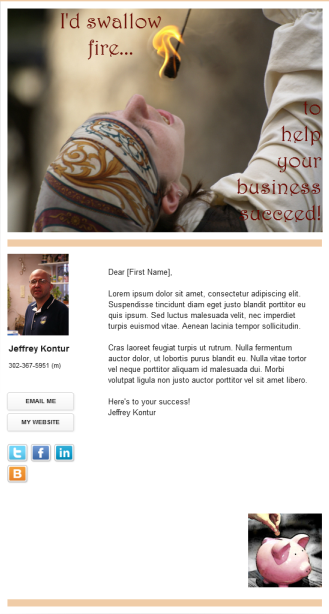The way that many companies keep their customer lists, they have the names and assorted contact information for everyone who’s ever bought from them and gave them such information. That’s about it.
And this is those companies that even bother to keep customer lists at all.
Of course the really good companies keep much more. Why do you suppose large retailers and service companies have loyalty programs? Frequent flyer programs, frequent buyer programs, grocery store discount cards… you name it.
Those programs serve two very important purposes:
- By making customers fill out an “application” to sign up for their program, they are getting those customers to give them a great deal of information: full name, address, email, phone number and sometimes more.
- Every time a customer uses his card or account number, the company logs what was purchased. (Yes, even your two foot long grocery store receipt with 133 items on it.) In that way, they can build up a very detailed history of exactly what any given customer likes, as opposed the customer seated across the aisle or the guy in the room down the hall.
Savvy companies milk this information for all it’s worth and extend custom-tailored offers to each customer. Naturally, by offering what you’ve already demonstrated you like and will purchase frequently, it greatly increases the odds of making another sale.
Or perhaps they make a special offer on somethingyou don’t normally buy. Most likely something complementary to what you usually buy. Only stay in the hotel on weekdays but never on weekends? By offering to extend your stay for a reduced price, perhaps they can induce you into longer stays that include weekends. Always buy the name brand cookies but the store brand of lots of other items? If they can convince you to give their store-brand cookies a try, they stand to make more profit. (Even though the price is lower, the margins are typically higher.)
But that’s about as far as it goes.
So what’s missing?
A lot, as it turns out.
How many companies distinguish between current and former customers? When customers stop buying from you, there will rarely be an announcement. There’s just a change in buying behavior and you may never know why.
Perhaps that salesman who flew three out of every four weeks is now an executive who hardly travels. Or the family of five who bought groceries every week was lured away by a new store. Or moved to another state.
How do you even define a former customer? How long do they have to go without making a purchase before they make it into that category? Is there hope of rescuing the business relationship before it comes to that?
And what of prospects who gave you their information but then never actually became customers at all? Do you save that information? What do you do with it?
Most companies will try for some time to lure those prospects into becoming customers. (Some keep trying indefinitely.) They may change the offers around a little, dangle a different carrot, so to speak, but that’s really about the extent of it.
Here’s a radically different idea: what about giving those prospects and stale former customers to one of your direct competitors?
Of course I’m not talking about some kind of twisted professionally self-destructive altruism. Instead I’m talking about a trade. You give one of your competitors “x” number of prospects who never converted plus former customers who obviously aren’t coming back and, in return, they give you the same number of their unconverted prospects and former customers.
Why?
If these prospects gave you their information, it was most likely because they needed or wanted what you have to offer. They were interested in becoming customers but then something happened. It could be that they changed their mind, or that your price was too high, or they heard or read something about you that they didn’t like, or they had a negative interaction with someone at your company, or decided to buy from a competitor instead.
The reason doesn’t really matter all that much.
What matters is that, unless this was a one-time only need that’s already been satisfied, these prospects have selected themselves as potentially good customers for someone in your industry. Just not for you. (If that were the case, you would already have converted them into customers.)
The same is true of your competitor’s unconverted prospect list; those are potentially great customers for someone but not for them.
So you’re both sitting on lists that have tremendous potential value to some company in your industry. It only makes sense then to exchange lists. They stand to wring some value from yours while you stand to wring some value from theirs.
This combination of cooperation and competition is called “coopetition”.
This is not collusion. You’re still competitors, you’re just engaging in a more enlightened form of cooperative competition.
Of course there is the possibility that many of the prospects you get from your competitor may already be your customers. They run the same risk with your list. That’s just part of the cost of this kind of transaction.
Another major consideration is concern over privacy. One of the things you can most easily do is to not actually exchange lists but each merely send out a solicitation on behalf of the other. If trust is a concern, you could mutually agree on a third party mailer who will process both lists. That way, the information never actually changes hands.
The only way you get your competitor’s prospect information (and vice versa) is if one of those prospects responds to the mailing and you collect it from him directly.
Click any of the icons below to retweet these passages from the above article.
 Do you engage in “coopetition”? You should!
Do you engage in “coopetition”? You should!
 Why do you suppose large retailers and service companies have loyalty programs?
Why do you suppose large retailers and service companies have loyalty programs?
 Customer loyalty programs serve two very important purposes:
Customer loyalty programs serve two very important purposes:
 Savvy companies milk this information for all it’s worth.
Savvy companies milk this information for all it’s worth.
 What of prospects who gave you their info but then never converted? What do you do?
What of prospects who gave you their info but then never converted? What do you do?
 This radical strategy is not twisted professionally self-destructive altruism.
This radical strategy is not twisted professionally self-destructive altruism.
 This combination of cooperation and competition is called “coopetition”.
This combination of cooperation and competition is called “coopetition”.
 A more enlightened form of cooperative competition.
A more enlightened form of cooperative competition.





 After the meal, my wife and I both ordered coffee. I’m not really much of a coffee drinker but I will drink it sometimes just for taste.
After the meal, my wife and I both ordered coffee. I’m not really much of a coffee drinker but I will drink it sometimes just for taste.
 When sending one-off messages (and even for your autoresponder messages for that matter), there are two schools of thought. One is that you should format them in plain text because the content is key and you don’t want bad formatting or missing graphics to get in the way of the message you are conveying. In fact, if you are going to send a plain text email you should manually insert line breaks at around 60 characters. Do not rely on automatic text wrapping. It will break the lines in a different place for everyone and may make your messages awkward to read. Better that you control it.
When sending one-off messages (and even for your autoresponder messages for that matter), there are two schools of thought. One is that you should format them in plain text because the content is key and you don’t want bad formatting or missing graphics to get in the way of the message you are conveying. In fact, if you are going to send a plain text email you should manually insert line breaks at around 60 characters. Do not rely on automatic text wrapping. It will break the lines in a different place for everyone and may make your messages awkward to read. Better that you control it.